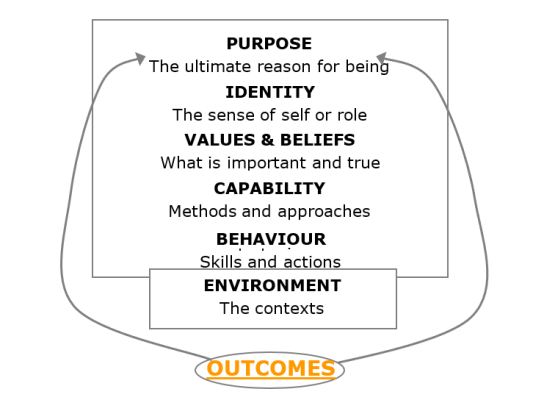What on Earth does Harrison Assessment have to do with Personal Values?
Let me explain –
The following model is affectionately referred to as the Alignment model in Leadership Development Circles. From top to bottom it suggests that at the highest level we have a purpose in everything we do from our existence to our reasons for attending a meeting or having a conversation with a loved one. In the pursuit of achieving that purpose we adopt an identity – What role am I in playing in the achievement of said purpose? Am I a learner, a facilitator, an information giver, listener, friend or something else? What is important to me about this purpose, ie, what values do I hold and what beliefs support these values? As a team leader what do I value most, the achievement of the task by a certain time or the development of the team in the pursuit of achieving the task? What skills and capabilities have to be in place to achieve the purpose and ultimately effect a change in behaviour which will have a positive impact on our surroundings or environment.
All too often as human beings we judge the behaviour of a person, team or organisation as it’s the bit we see and are affected by. Taking a step back to wonder what beliefs and values sit behind the behaviour often presents alternative conclusions.

So let’s take a look at the Harrison paradox report – a report which derives from the behavioural preferences of the inputter. For more on this excellent assessment check out my website at www.quadrant1.com. The following set of paradoxical behavioural traits has been taken from a set of 12 which indicate an overall approach to work based on behavioural preference.
 The ability to combine warmth and empathy with enforcing the agreed rules would result in a flexibility of behaviour we call ‘compassionate enforcing’. In the example given, however, there is a strong tendency towards warmth and empathy and a low desire to enforce the rules. Relate this back to the model and you can see that these two axes represent the personal values of the person and the resulting behaviour is one of permissiveness. The unconscious (or sometimes even conscious) behaviour of others around could be to ‘take advantage’ with all the consequential outcomes that permissiveness brings. The large red hurricane in the ‘harsh’ quadrant is an indication of what happens when this person is put under pressure – maybe to achieve a deadline or target of some sort. Behaviour suddenly goes against the value set of warmth and empathy and becomes harsh, taking all by surprise because it is out of character. Depending on how this person manages their stress this may even be perceived as their normal behaviour if it happens often.
The ability to combine warmth and empathy with enforcing the agreed rules would result in a flexibility of behaviour we call ‘compassionate enforcing’. In the example given, however, there is a strong tendency towards warmth and empathy and a low desire to enforce the rules. Relate this back to the model and you can see that these two axes represent the personal values of the person and the resulting behaviour is one of permissiveness. The unconscious (or sometimes even conscious) behaviour of others around could be to ‘take advantage’ with all the consequential outcomes that permissiveness brings. The large red hurricane in the ‘harsh’ quadrant is an indication of what happens when this person is put under pressure – maybe to achieve a deadline or target of some sort. Behaviour suddenly goes against the value set of warmth and empathy and becomes harsh, taking all by surprise because it is out of character. Depending on how this person manages their stress this may even be perceived as their normal behaviour if it happens often.
Here’s another example – this time with another layer of detail represented by the trait requirement for a specific role (hence the colours).
This paradox represents the communication style of the person and, in my opinion, is probably one of the most important of the 12 paradoxes because it is the bit that people hear, see and feel and therefore make instant judgements upon.
Imagine a normal behaviour which appears totally in the top left, ie blunt. It would suggest a high value around frankness resulting in blunt behaviour which is generally accompanied by body language. I have often heard people with this pattern refer to themselves as ‘honest’ which by definition would appear to mean that they believe people with the opposite style are dishonest. Not true of course! They may just not want to hurt feelings or get into an argument. But think of the consequences this extreme behaviour could have – how many great ideas are they missing, or problems they are not being informed about, what impact are their beliefs around frankness having?
I have discussed just two of the 12 paradoxical graphs here and emphasized the importance of accessing the values and beliefs behind unproductive behaviours if we have any hope of changing them. The Harrison Assessment system has so much to offer matching people to job roles, assessing potential leaders and job satisfaction for individuals and teams. I have watched it contribute greatly to culture change and reduce staff attrition rates. In a world where mental health issues are becoming so prevelant doesn’t it make sense to start with behavioural preference awareness? I am a great believed in prevention rather than cure.
If you would like to know more about the Harrison Paradox approach, you can email pat@quadrant1.com or give me a call on 44 (0)7768 922244.


